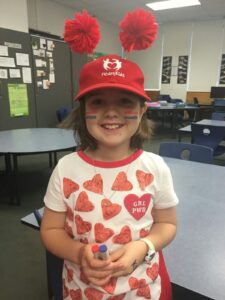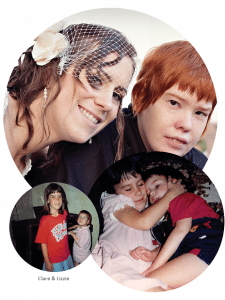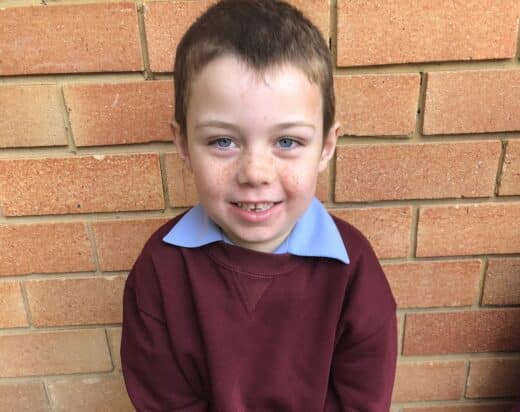Harrison
By Amanda Highet, Harrison’s mum (South Australia, August 2020)
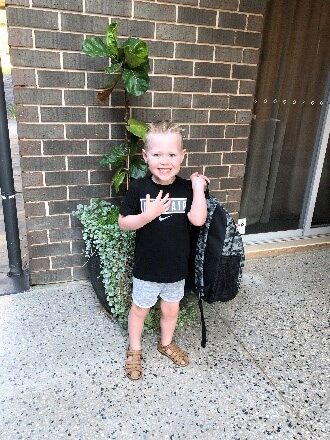
Harrison is just about to turn 5 and was diagnosed with TSC at 5½ months of age. He lives in Hahndorf, South Australia with his parents Amanda and David, and older brother, Max.
Looking back, Harrison’s first years were definitely a struggle, but everything we have done has been worth it to get him where he is today. Without a doubt, we believe Harrison is doing so well due to the early diagnosis and early intervention.
At our 20-week pregnancy scan, we were told that there was a small calcification on our baby’s heart but that it shouldn’t be an issue and not to worry. We were advised to see a cardiologist after the birth just to be sure.
Harrison was born in late August 2015. He was a big baby and looked strong and healthy. His brother Max, who is 22 months older, instantly adored him and our little family was complete. When Harrison was 6 days old we went to see the cardiologist, who informed us that Harrison had 3 tumours (cardiac rhabdomyomas) on his heart and that this was in fact quite serious. We had gone into this appointment thinking it was going to be nothing more than routine, so both my husband and I were in complete shock and totally devastated. Our cardiologist was supportive and exceptionally thorough. He recommended that we also have Harrison’s brain and kidneys scanned as sometimes these types of tumours can be linked to a genetic disease.
The kidney and head scans were conducted at the Women’s and Children’s Hospital in Adelaide when Harrison was just 5 weeks old. Both these scans came back with no findings.
At approximately 4½ months old, we noticed that Harrison was having small episodes where he would clench his hands and upper body. We had no idea what they were, and we didn’t think too much of them initially. The episodes then became more and more frequent and began lasting longer and longer. Thankfully my mum discussed these episodes with a friend who is a nurse and she said it sounded like he could be having seizures. Looking back now, this conversation was pivotal, as, without it and the steps that followed, Harrison’s life could have been very different. After witnessing a lengthy clenching episode the next afternoon, my dad convinced us that we needed to get Harrison to the hospital as soon as possible and not waste time by going to see a GP first. We headed down to the Women’s and Children’s Hospital the very next morning.
After giving an outline of Harrison’s background and showing video footage of the clenching episodes to the emergency doctor, we were seen by a neurologist who said he thought they were infantile spasms. Due to the heart tumours, the neurologist then conducted the wood lamp test but no shagreen patches were seen on Harrison’s skin. We spent two days in hospital while an MRI, EEG and organ scans were conducted. On the second day, my husband and I were told that Harrison may have a rare genetic disease called Tuberous Sclerosis Complex.
Our first three and a half years with Harrison are now a total blur. We have no idea how we made it through. He suffered from severe sleep disturbance and would generally sleep in intervals ranging from just 30 minutes up to an hour and a half at most. Together with the countless hours at the hospital and therapy, life was exhausting.
We were told that in addition to the cardiac rhabdomyomas we already knew about, Harrison had an uncountable amount of benign tumours in his brain, cortical dysplasia, subependymal nodules, retinal hamartoma, renal angiomyolipomas (AMLs) and focal epilepsy.
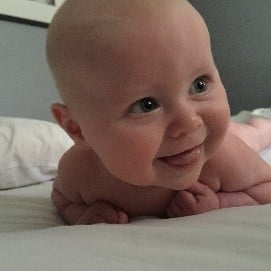
We were both left feeling extremely upset and were in total disbelief that our little boy was so sick. It was just heartbreaking. We had so many questions. Our minds raced with the ‘what ifs’. We were told by our new hospital paediatrician, not to google but we couldn’t help it, especially me.
Harrison started on vigabatrin straight away and thankfully his seizures almost completely stopped. We were allocated an amazing team of doctors, including the genetics team who tested all 4 members of our family. Harrison came back with a clear TSC2 mutation and a formal diagnosis was given. The rest of us had no match for TSC, Harrison had a sporadic mutation.
Harrison was diagnosed with developmental delay and he began seeing an Occupational Therapist, Speech Pathologist and Physiotherapists for land-based and hydrotherapy treatment at the hospital. With Harrison’s therapy, scans and specialist appointments we were at the hospital up to 3 days per week. It was exhausting and extremely overwhelming. I felt like I was constantly in tears. We had to continue working and try to keep everything as normal as possible for our eldest son, Max. We could not have done it without the help and support of all our amazing family and friends, especially my parents who would drop everything to help us at any time of the day or night.
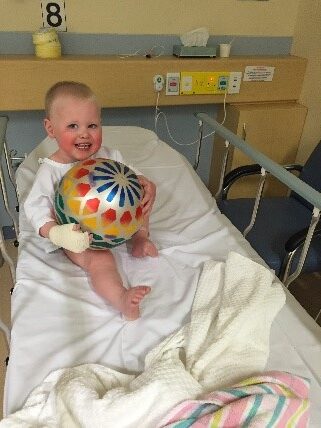
Harrison continued to receive his therapy and responded extremely well to his seizure medication and we carried on with our new way of life as best we could. Then, just after his first birthday, he had a bad episode. He went pale, his heart began racing and he started to vomit uncontrollably. He went into a trance and we could not get him to engage – he gave no response and just stared up to one side blankly. We called an ambulance and he was rushed to hospital where he was in resuscitation for what felt like forever as they could not get him out of the seizure. This was by far the scariest time in our TSC journey. Watching our poor little boy on the table, not responding and us being unable to do anything to help. We spent the night in hospital, and the next day I had a crash course in Midazolam, a medication commonly used as an emergency treatment for prolonged seizures. We were so worried, but as the doctors predicted, Harrison bounced back and was fine a few days later.
About a year after Harrison’s diagnosis we were lucky enough to secure NDIS funding and were able to start independent Physio, OT and Speech Pathology at home. This made a massive difference to our lives. Although he was developmentally delayed in all areas, Harrison eventually started reaching some of the big milestones. He started walking at about 17½ months, which we were totally surprised by. He has shown such persistence and determination with everything he does. His therapists have been amazing, and we know Harrison wouldn’t be where he is today without them
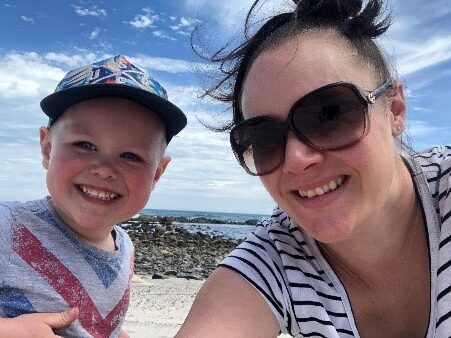
When he was about two and a half, Harrison had an abnormal ERG which is an electroretinogram that measures the electrical response of the light-sensitive cells in your eye. This test showed reducing amplitudes, which are the length and width of the brain waves, this was attributable to the vigabatrin. His medication was switched to keppra. Although he had no further seizures on keppra, this medication seemed to affect his personality and he became quite withdrawn and aggressive at times. He would bang his head against the ground to the point of splitting it open when he could not deal with his emotions or a situation. Tantrums were next level and became worse the older he got. When things got too much for him, Harrison would go into shutdown mode and go to sleep. He still does this now, but thankfully not as often.
Our first three and a half years with Harrison are now a total blur. We have no idea how we made it through. He suffered from severe sleep disturbance and would generally sleep in intervals ranging from just 30 minutes up to an hour and a half at most. Together with the countless hours at the hospital and therapy, life was exhausting. Initially, we had scans and specialist appointments frequently for cardiology, ophthalmology, renal and neurology plus, MRI’s, EEG’s, ERG’s, general medicine, genetics, genetics counselling and later dermatology. It was a never-ending cycle, but we pushed through to do everything we could to help Harrison. Thankfully, the number of scans and appointments lessened as he got older and most of the tumours were classified as stable.
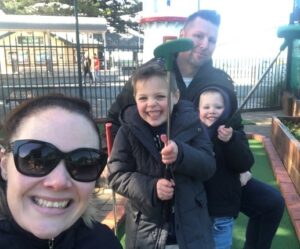
At the start of 2019, we started Harrison at an Early Learning Centre to help with his social interaction. It took 7 weeks to transition him and it was extremely difficult emotionally to watch and trust someone else to care for our sick child, but it was totally worth it in the end. The benefits were huge. He grew and developed so much, which helped prepare him for mainstream kindergarten.
Just after his fourth birthday, Harrison was assessed and then diagnosed with autism spectrum disorder. Around the same time, his facial angiofibromas began to become quite noticeable and so we began using the sirolimus cream. But then came some good news. Given that he had been seizure free for 2 years, his neurologist decided it was time to try and wean him off his epilepsy medication. We saw an incredible difference in him almost instantly. For the first time, we felt like we were getting to know the real Harrison – a sweet, cheeky and quirky little guy. I remember getting my first real hug and finally feeling some warmth and affection from him.
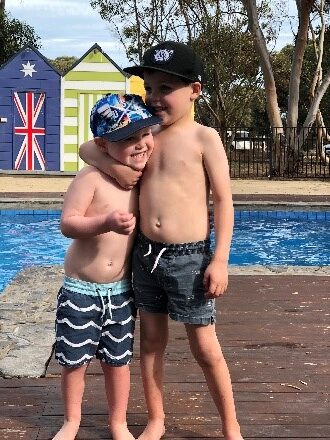
From this time, life has been good. Harrison is doing extremely well. He continues his therapy, but now has far less hospital scans and appointments. His heart, eyes, and brain tumours are all stable and he remains seizure free. He has multiple lesions in each kidney which are increasing in size, but at a gradual rate and we are hoping no action will be needed until he is in his late teens/early twenties. His facial angiofibromas are also under control. Harrison still suffers from sensory overload, development delay and needs assistance in social interactions, but overall he is going amazingly well. And, he finally sleeps…most of the time!
Harrison was able to start mainstream kindergarten at the start of 2020 and is absolutely loving it. We are so proud of all that he has achieved. He is the sweetest and kindest little guy who really is living his best life possible with TSC. He loves the movie Cars (he watches it every day without fail), ball activities, building sandcastles at the beach, his family (in particular he has an amazing bond with his grandparents and youngest cousin), and he has a funny obsession with numbers and counting. Our family and friends have learnt to adapt to his quirky and repetitive behaviours and can gauge when he is getting overloaded and needs to remove himself from a social setting.
Through a TSA conference, we were lucky enough to meet another Adelaide-based TSC family. Harrison and Felix are 4 months apart in age and it’s so great to catch up and be able to share this crazy journey together. It’s really reassuring and lovely to have the support and understanding of another parent going through the same thing.
We are always very mindful that Harrison’s condition might change at any time but have learnt over the years to take each day as it comes. One of the hardest things of being a parent of a child with TSC, is the not knowing. We hold our breath at each scan, always terrified of what it may reveal, but we have learnt to stay positive, no matter what the outcome. Harrison’s journey has taught us so much and made us really appreciate the little things in life.

